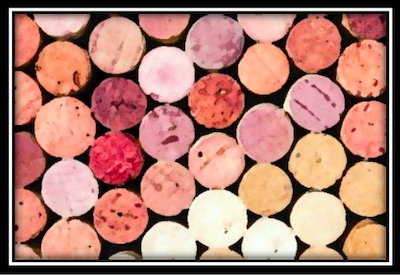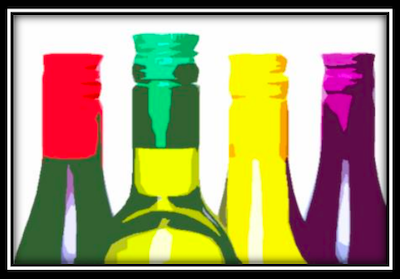CLOSED EASTER SUNDAY // HOURS: TUESDAY-SATURDAY 12-6PM, SUNDAY 11-5PM
Vol. 13 - "Supreme Cork Ruling: TCA v. Stelvin"
The Final Supreme Cork Ruling:
TCA vs Stelvin:
"Rege Stanas" or the Fallen Angel
Book of Bertil 13.01

PRELUDE:
Do you believe in the stigma surrounding the screw cap wine bottle? Or rather, would you rather buy a bottle of wine with a cork or one with a screw cap? And now if we tested your resistance threshold...
CHAPTER 1.0
Introduction:
The two biggest mistakes man can make are to believe before he knows, and to assume that others know before understanding his own beliefs. So, mea culpa, for I have sinned and repent before you today. Because I am deep- rooted follower of the use of the screw cap, I often forget that others, perhaps, continue to believe otherwise in the benefits of the “fallen angel” known as the natural wine cork. I therefore offer you a summary of the Supreme Cork judgment of TCA v. Stelvin to provide for some enlightenment and to properly unclog the bottleneck on this contaminated and poisonous subject. The question is, “May I convert you by faith in my reasoning?”
"And all those who attended this spectacle, after seeing what had happened, turned back, hitting their chests." (Luke 23:48)

Opening Statements: 13.01
13.01 The Cork stopper as we know it now has not always existed in the history of wine (beginning 3,000 BC). It first appeared about 2,000 years ago to plug clay amphorae, then disappeared almost completely for a few centuries with the arrival and use of the wooden barrel. Its current form (without the addition of fabrics or tar) came about at the same time as the bottle of wine as a product for storing and transporting wine. It was not until the end of the nineteenth century that the cylindrical cap became the world standard for wine bottle corking. Its success is due to its natural properties of impermeability to liquids and for its high elasticity (ease of capping and sealing). It is also prized because it allows a very small amount of air to pass through the bottle (micro-oxygenation) and allows the wine to evolve by developing new molecular structures over time (aromatic evolution). It is a very responsible product since it is part of an ecological approach. Cork (the tree) is a durable material since it is not necessary to cut down the tree to extract the cork (its bark) which will recompose naturally. In addition, it’s very high consumption of CO2 by photosynthesis for the reproduction of its bark, makes it a superhero of modern times. But then what is the problem and why does he have to defend himself today before you, against this second-hand and completely "unnatural" product the screw cap "Stelvin"?

13.01.2 The Screwcap or Stelvin Closure
The so-called "Stelvin" screw capsule was invented in France in 1964 to counteract the problem of TCA (2.4.6. Trichloroanisole known as “cork taint”)* which affects 3-5% of wine production worldwide that has been corked with a natural cork (other than artificial cork or composite cork). This capsule made of aluminum and an airtight closure system makes it possible to seal with high quality a bottle of wine at a level equivalent to that obtained by a cork. With low production cost, this capsule can be manufactured anywhere that applies Stelvin manufacturing standards. This capsule, depending on its model and price, preserves the wine in optimal conditions of stability and aromatic constancy. Its technological quality and reliability have made it for some years, and is not the only corking allowed for wine bottles in Australia, New Zealand, Switzerland etc. It's simple to manufacture, resulting in low carbon footprint production, and it’s completely recyclable, guaranteeing the perfect alternative to cork. So why is it so snubbed by consumers and only accounts for 15% of the world’s capping? Is this resistance from the winegrower or the consumer?

Statistics and Data:
The global number of wine bottles opened in 2021 was 33 billion. We should consider that 75% of those bottles use natural cork, and that of those an average of 3.5% were contaminated with TCA. So in 2021 alone consumers may have been drinking 866 million faulty wine with all the faulty aromas of wet newspaper & musty basement with tastes of bland, flat, inelegant wine, reminiscent of old moldy smelling wine. If the average cost of a bottle of wine globally is $12, then over a billion dollars of investment in pleasure has turned into a disaster.

CHAPTER 2.0
Facts and Charges 13.2.1
More than 85% of cork production occurs in Portugal, and it takes between 30 to 40 years for the cork oak to regenerate its bark in a qualitative way. Today's cork forests can no longer meet the ever-increasing demand for the overuse of cork in the wine industry. As a result, the varied quality of the bark and price competition force producers to heavily use insecticides, pesticides, fungicides, and chemical fertilizers in cork forests. This accelerated overproduction compromises the quality of the cork produced, and greatly increases the percentage of TCA infection. To combat this risk, intense treatments of fungicides, chlorine washing, and treatment of chemical insecticides are necessary. The chemical residue spreads over time in the wine and makes it unstable and polluted. In addition, oak bark is uneven in its growth and quality varies. The younger the bark (10 years) the more the cap produced will be filled with venules (lenticels) and will produce a poor-quality cork that will become very friable and porous, likely allowing unwanted air in or crumbling into your wine.
A cork measures in length from 1.4” - 2.1”. Long corks over 2” taken from bark over 30 years old are generally reserved for very grand wines for long-term ageing (35 years or more). Shorter corks when coming from younger bark are intended for the corking wine to be consumed in the next 5 years or less, often for immediate consumption.

The price for a short cap of average quality is ~ $0.35 per unit, and with a very high-quality long cork, the range is between $2-5 per.
Even if the cork is a 100% biodegradable, organic and natural product, the result of its carbon footprint by its geographical centralization of production is huge for such a short use and increasing chance of cork taint (TCA). We can also acknowledge that more than 95% of corks will never be recycled.
This industry continues to flourish, though, because behind cork lies a story of snobbery. A study on the subject carried out by Charles Spencer of Oxford University where half of his tasters (group 1) drank a wine with a cork and to the other half (Group 2) a bottle with a screw cap. Group 1 tasters rated the quality 15% higher than group 2. The wines were later revealed to be identical. This demonstrates the sentimental attachment to cork by wine consumers.
This confirms once again that these choices of preference are more about the container than the content regardless of the the ecological impact.
Addition:
Infection of wine with TCA can also sometimes be due to contamination of the wood barrel or an external factor in the environment, such as being in contact with another previously contaminated wine, or unsanitary production or storage. The formerly used lead “capsule” (now aluminum foil or plastic) that hermetically covers the cap and neck of the bottle has the function of limiting these risks of contamination.
The stigma of the screw cap is that it is ugly, made of aluminum, lacking the romance of a cork because it is industrial, and it cracks without the pop. For production, these require aluminum. Although aluminum is not present in all countries, it is easy to recycle aluminum from other sources. It is thus possible to produce screw caps anywhere in the world, and then 95% of the capsules (whole or partial) go to the recycling bin. The average cost for a Stevin capsule is between $0.05 - $0.18 and its production represents only 0.001% carbon footprint compared to that of the natural cork. Other great advantages that are impossible to achieve with the cork is to seal the bottle perfectly, to omit the risk of the cork taint (unless the wine barrel itself is contaminated with TCA, which is extremely rare), to avoid the risk of drying out so the bottles can be kept standing upright and without the need for humidity control. But above all, the screwcap’s quality of a tight seal (unlike synthetic corks) is never faulty.
Yet there are disadvantages; The Stelvin screwcap preserves the wine hermetically and doesn’t allow the air exchange that the wine needs over time to evolve in bottle (organoleptic evolution). The wine will retain only its primary aromas of freshness without progression towards tertiary aromas. (Although new technology now allows oxygen transfer via the capsule to the wine). We do not yet know the stability of a screw capped wine 30-50 years from now. As for the cork, it has proven itself, but the biggest reluctance is its commercial image. For more than 50 years it has been used to a very large extent for the marketing of wines that can be expensive (still today) and is very poorly associated with luxury and exceptional products. It's like the Volkswagen (People's Car- The Beatles) owned and built by Porsche—the whole issue of social perception.
CHAPTER 3.0
The Verdict 13.3.1

It is clear from this presentation that each of the parties has their advantages and disadvantages. We must therefore take into consideration three determining factors to make resonated choices.
1. The risk on economic investment:
The risk for the consumer to have a loss on the investment (TCA faulty wine) is 3% to 15% depending on the quality of the cork. The Stelvin capsule when it represents an almost zero risk of loss (0.0001%). The screw cap is therefore the most reliable product with a return on investment of more than 99.999% and a 100% guarantee of consumer satisfaction.
2. The risk on green investment:
It is important to differentiate between a natural product and an ecologically responsible product. It has been previously shown that the cork, a natural product, has a very negative environmental impact on the ecology of our planet and a direct impact on climate change. If we stopped the production of natural cork altogether (bark extraction) the tree would continue to absorb the same amount of CO2 into the atmosphere, while reducing its carbon footprint impact by 100%. As for the Stevin aluminum capsule that has a tiny environmental impact will eliminate 100% production the capsule (cap) covering the cork (lead, aluminum or plastic) making it a product has 100% zero environmental impact and even a reduction in this carbon impact. But here the capsule is not natural!

3. Risk to business design:
The human confuses culturally, the beautiful and the good. An exceptional product that is not of primary necessity must be exceptionally attractive by its packaging rules established by social codes. The choice of a wine for the consumer goes first through the appearance of the bottle and its visual appearance (label and capsule), it is only second that the price will become the factor in the choice of purchase or rejection. The formula is therefore not in the desire of the consumer to choose a wine appropriate to its organoleptic standards but in the first place on the appearance of the product. The most terrible of its wines are those of extremist winemakers of the Natural Wine movement. They claim out of respect for the environment and the health of healthy wines, without added sulfite, without chemistry in the vineyard or in the cellar. And yet, they all have fake, in addition to playing on the appearance, by anti-normative labels, they have now removed the protective capsule from the cap, not for ecological or economic reasons, but to allow consumers to see the cork, and therefore place it as a superior product. Do not be deceived by this little game, take a good look at the cork before buying. It is always short, very often filled with venules, and very often not natural at all, because its manufacture is worse than that of the screw cap. It is very often of industrial manufacture, such as the composite stopper (compressed and bonded cork powder) or synthetic (polymers-plastic, vegetable but most often second source of crude oil).

THE CONCLUSION
I do not want to ask to make impartial choices, but resonant and reasonable choices. We are the force that can change the course of history while making no compromise on the quality of the products we want to consume. Imagine a world, like in Australia, where the cork no longer exists. Wine of thirst or wine of long guard, all has the same sauce. "The screw cap for all". So why do American winemakers hesitate?
Because the embargo of cork producers is powerful, their macher represents $ 1.8 billion in 2021 and their marketing force (like Champagne) is extraordinarily effective since it is based on the decision of emotion and not rationality. It is shown that the consumer is willing to pay 10% to 25% more for the same wine if it is attractive by its label and is equipped with a cork.
I therefore propose that you be an active actor of change. Change your habits and first choose a wine that suits you in its tastes, price, and then its appearance. Always decide for equal quality, the wine with a Stelvin capsule before the one with a cork. Support exceptional winemakers like Randall Grahm or Bob lindquist who make no compromises and are ecological in all their winemaking decisions, from the vine to the table. Publish, photograph, Verbalize your decision and your choice for the screwcap. Yes, we can do it all together.
Finally, let's preserve the cork oak forest, let it age and become healthy and ecological again. Acceptance to produce only high-quality cork for very grand wine for ageing. As this everyone will be happy including our planet.

Mr. B
*Memorandum: My words and opinions in these newsletters are and would always be personal, and I intend to offend. I always accept that others have the full right and duty to challenge me, to argue, and, if it is necessary, excommunicate me from their beliefs (often dull and hollow) because I would act the same way if it were the other way around.
Display prices in:USD

